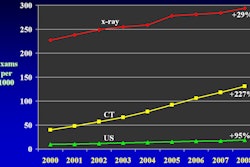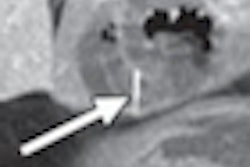Repeated imaging scans are a big contributor to rising healthcare costs. Researchers from Taiwan investigated the phenomenon in a study of 2 million patients and found that repeat rates vary by facility and disease type. They offer guidelines for appropriate repeat rates in a study in the April issue of the American Journal of Roentgenology.
The researchers found a high rate of repeated CT and MRI scans within 90 days, with greater utilization tied to the initial diagnosis and the type of hospital in which a patient is evaluated. Of more than 2 million patients who underwent CT and MRI exams in a two-year period, repeat CT and MRI scans within 90 days accounted for 21.5% of all examinations performed, with malignant diseases accounting for 32% of the maladies imaged.
"This knowledge should aid in the review of healthcare policies so that guidelines for repeat scanning may be tailored to the different levels of hospitals into different diseases to achieve maximum efficiency within a limited healthcare budget," the authors wrote.
The lead study author is Dr. Ran-Chou Chen, from the department of biomedical imaging and radiological sciences at National Yang-Ming University in Taipei in the department of radiology at Taipei City Hospital (AJR, April 2012, Vol. 198:4, pp. 858-865).
Imaging costs
Chen and colleagues cited previous research that found that repeated imaging exams account for approximately one-third of the costs associated with radiologic scans, and the number continues to grow annually. They also cited a study that concluded that the total cost of imaging could be controlled if repeated exams were minimized.
Using the Taiwanese Bureau of National Health Insurance database for 2004 and 2005, researchers gathered information on benefit claims for all healthcare services, including inpatient, outpatient, and emergency departments, for some 22 million Taiwanese residents.
During the two-year period, there were 80 public hospitals, 188 private hospitals, and 73 not-for-profit hospitals in Taiwan that used CT, MRI, or both. Because a CT or MRI scanner must be in a hospital and not in a clinic, there were no outpatient imaging centers included in the study.
The final study population included a total of 2.2 million patients, 56% male and 44% female. Among them, 463,381 patients underwent multiple CT, MRI, or both within 90 days.
"The reason for choosing 90 days as the cutoff was a need to exclude necessary examinations performed during a second episode of illness or during an annual health screening," the authors wrote.
Also, during that time, 1.7 million people received CT, 402,342 individuals underwent an MRI, and 37,652 subjects were given both CT and MRI.
More scans for men
The analysis found that patients older than 65 years underwent the most imaging exams (38%), followed by patients between the ages of 45 and 64 years (33%). Men also accounted for 57% of all CT exams and 51% of MRI scans, and 58% had both CT and MRI.
Among the CT exams, malignancy accounted for the greatest number (21%), followed by neurological disorders (18%). MRI was used most often for musculoskeletal issues (42%), followed by neurological disorders (19%). Both CT and MRI were utilized most for neurological disorders (40%), with malignant disease ranking second (21%).
|
As for repeat CT and MRI exams, 463,381 scans (21%) were conducted within the 90-day timeframe. Malignant diseases (30%), neurologic disorders (21%), and brain or spinal injury (8%) were most often the reasons for the repeated exams. By comparison, CT and MRI were only used 2% of the time for infectious disease cases.
Surgical intervention
The study also found that during the two-year period, CT and MRI scans helped to prevent surgery for patients, as 1.6 million (75%) cases avoided the need for surgical intervention. Among the 25% of patients who did require surgery, 191,419 people (35%) received a repeat CT or MRI within 90 days of the original scan.
"Among patients who did not receive surgery, the repeat rate was only 16.9%," the authors wrote. "Thus, patients who received surgery were proportionally more likely to need to undergo CT, MRI, or both within 90 days."
Not-for-profit hospitals utilize CT and MRI the most, with 1.1 million exams (52%), while medical centers performed 974,247 CT and MRI procedures (45%). Medical centers also were more likely to perform repeat scanning, accounting for 52% of the total, while community hospitals ordered only 8% of repeat CT and MRI exams.
More than half (55% or 256,494) of all the repeat examinations were done at the same facility, with medical centers performing repeat exams in 59% of the cases. By comparison, only 34% of repeat exams were done at the community hospitals where the initial diagnoses took place.
To achieve "maximum prioritization of resources with a limited health care budget, suitable guidelines for CT and MRI examinations need to be tailored for the different levels of hospitals and for different diseases," Chen and colleagues concluded.
The researchers recommended a 25% repeat rate for medical centers, 20% for regional hospitals, and 13% for community hospitals.
"As for diseases, we recommend 32% as the upper limit of the repeat rate for malignant diseases, 25% for brain and spinal injuries and neurologic diseases, and 20% for the remaining diseases," they wrote. "The repeat rate limit could be raised to 35% if the patient underwent surgery."




















